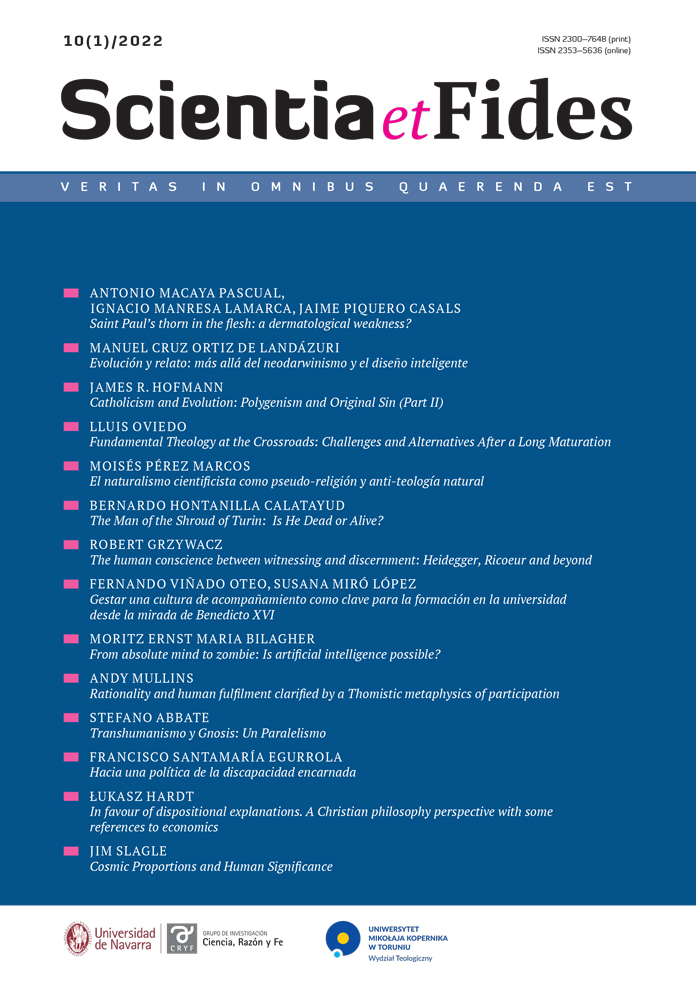Cosmic Proportions and Human Significance
DOI:
https://doi.org/10.12775/SetF.2022.013Schlagworte
medieval cosmology, size, value, PtolemyAbstract
A common misperception, both within academia and without, is that the premodern, Judeo-Christian picture of the universe was of a small, cramped one. This allowed people to believe that the Earth and its inhabitants were the most important thing in it. But this misfires in several ways: First, the premodern cosmos is only small in comparison to what contemporary science has discovered, not absolutely. Second, the premoderns felt just as insignificant as we do in light of the universe’s size, but we cannot translate this into a scientific or philosophical argument. Third, it assumes that the Judeo-Christian view is that humanity is the most important thing (rather than God) and that God created the universe for us (rather than himself). Fourth, whatever value human beings have in the Judeo-Christian tradition is derivative, based on being created in God’s image, and the size of the universe has no bearing on it.
Literaturhinweise
Aquinas, Thomas. 1952. Summa Theologica, translated by the Fathers of the English Dominican Province, revised by Daniel J. Sullivan. Great Books of the Western World, vol. 19: Thomas Aquinas, I. Chicago, etc.: Encyclopædia Britannica, Inc.
Aristotle. 1952. On the Soul, translated by J.A. Smith. Great Books of the Western World, vol. 8: Aristotle, I. Chicago, etc.: Encyclopædia Britannica, Inc.
Boethius. 1918. The Consolation of Philosophy, translated by S.J. Tester. The Loeb Classical Library, vol. 74: Boethius. Cambridge, MA: Harvard University Press.
D’Evelyn Charlotte and Anna J. Mill, eds. 1967. South England Legendary, vol. 2: Text, reprint. Oxford: Oxford University Press.
Everitt, Nicholas. 2004. The Non-Existence of God. New York and London: Routledge.
Giostra, Alessandro. 2021. “Theology and Science in Copernicus’s Universe.” Scientia et Fides 9 (1): 131–47. DOI: https://doi.org/10.12775/SetF.2021.004.
Goldstein, Bernard R. 1967. “The Arabic Version of Ptolemy’s Planetary Hypotheses.” Transactions of the American Philosophical Society, n.s., 57 (4): 3–55.
Hawking, Stephen. 1988. A Brief History of Time: From the Big Bang to Black Holes. New York, etc.: Bantam.
Koyré, Alexandre. 1957. From the Closed World to the Infinite Universe. Baltimore: Johns Hopkins Press.
Lewis, C.S. 1960. Miracles: A Preliminary Study, 2nd ed. Glasgow: Fontana.
Lewis, C.S. 1964. The Discarded Image: An Introduction to Medieval and Renaissance Literature. Cambridge: Cambridge University Press.
Nietzsche, Friedrich. 1873 [2005]. “On Truth and Lies in a Nonmoral Sense,” edited and translated by Daniel Breazeale. In Truth: Engagements across Philosophical Traditions, edited by José Medina and David Wood. Malden, 14–25. MA: Blackwell.
Pascal, Blaise. 1670 [2005]. Pensées, edited and translated by Roger Ariew. Indianapolis: Hackett.
Ptolemy. 1952. The Almagest, translated by R. Catesby Taliaferro. Great Books of the Western World, vol. 16: Ptolemy, Copernicus, Kepler. Chicago, etc.: Encyclopædia Britannica, Inc.
Reppert, Victor. 2003. C.S. Lewis’s Dangerous Idea: In Defense of the Argument from Reason. Downers Grove, IL: InterVarsity.
Sagan, Carl. 1997. Pale Blue Dot: A Vision of the Human Future in Space. New York: Ballantine.
Van Helden, Albert. 1986. Measuring the Universe: Cosmic Dimensions from Aristarchus to Halley. Chicago: University of Chicago Press.
Downloads
Veröffentlicht
Zitationsvorschlag
Ausgabe
Rubrik
Lizenz
Copyright (c) 2022 Jim Slagle

Dieses Werk steht unter der Lizenz Creative Commons Namensnennung - Keine Bearbeitungen 4.0 International.
CC BY ND 4.0. The Creator/Contributor is the Licensor, who grants the Licensee a non-exclusive license to use the Work on the fields indicated in the License Agreement.
- The Licensor grants the Licensee a non-exclusive license to use the Work/related rights item specified in § 1 within the following fields: a) recording of Work/related rights item; b) reproduction (multiplication) of Work/related rights item in print and digital technology (e-book, audiobook); c) placing the copies of the multiplied Work/related rights item on the market; d) entering the Work/related rights item to computer memory; e) distribution of the work in electronic version in the open access form on the basis of Creative Commons license (CC BY-ND 3.0) via the digital platform of the Nicolaus Copernicus University Press and file repository of the Nicolaus Copernicus University.
- Usage of the recorded Work by the Licensee within the above fields is not restricted by time, numbers or territory.
- The Licensor grants the license for the Work/related rights item to the Licensee free of charge and for an unspecified period of time.
FULL TEXT License Agreement
Stats
Number of views and downloads: 1524
Number of citations: 1



